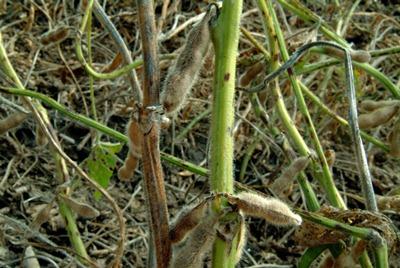By Daren Mueller, Department of Plant Pathology and Microbiology, and Clarke McGrath, ISU Extension and Outreach
Reports are trickling in about green stem syndrome (GSS) in Iowa soybean, which is like rubbing salt in the 2013 soybean crop wound. Before we get into details of the disorder, we wanted to let you know that the IPM program is doing an analysis to determine the most common causes of GSS. This article discusses the confusion about what actually causes this disorder. If you have a field with any level of GSS, we would really like to include it in our analysis. Please contact Nate Bestor (bestor@iastate.edu), Iowa State University pest management specialist, to see how you can participate.
Symptoms
Green stem syndrome (Fig. 1) is a soybean disorder in which stems remain green after pods and seeds are fully mature and ready to harvest. Cutting affected plants during harvest is difficult and seed quality can be reduced.
There is a classic definition of how GSS appears, but in reality, the symptoms vary quite a bit. Sometimes, plants with GSS can have just a few pods on the upper nodes, or there can be leaves still on at upper nodes in some spots. Also, immature green pods may be clustered on the upper part of the plant, and even empty pods have been associated with GSS.
Bottom line: if there are any mature pods in a field ready to harvest, and green, chewy stems are also present, this is considered GSS by our definition.

Figure 1. Green Stem Syndrome. Used with permission, Laboratory for Soybean Disease Research, University of Illinois.
Causes
Depending on the location, many different factors have been associated with GSS, including viruses (especially bean pod mottle virus), soybean aphids, thrips, stink bugs, leafhoppers, bean leaf beetles and Cercospora leaf blight. However, USDA research in Illinois showed no relationship between green stem syndrome and many of these factors. This doesn’t necessarily mean these factors do not cause green stem syndrome, but what is evident is that you can get GSS without these factors. Also, some of the symptoms described in scientific literature are not what we see in Iowa fields.
Some plant pathologists think that there is a separate viral or fungal pathogen that causes GSS, and it is yet to be identified. Some think that it is physiological. Evidence for a physiological effect comes from a research project from Kentucky where they dramatically increased GSS by severe pod removal. What conditions can cause a reduction in pods and an increase in GSS? Well, over the past few years, season long soil moisture stress seems to be a trigger, especially post flowering. When a soybean plant is growing normally at the beginning of the season, it produces high levels of carbohydrates to feed itself; when drought or other stress hits, pods can fall off or not fill in relation to the carbohydrate supply in the plant. If the plant has a pool of carbohydrates in reserve, it may stay green longer. That is one theory.
Other factors that have been associated with GSS, at least anecdotally, include lower fall humidity and higher fall temperatures that lead to faster drydown for the grain and not enough time for stems to dry. Also, foliar fungicides have sometimes been associated with GSS. This year the drought limited the number of acres receiving fungicide applications so this may not be a large factor this fall. Plant populations also have been associated with GSS, but oddly, both lower and higher populations have been accused of being the problem.
There have been many observational or anecdotal reports about varietal tendencies, but this is really hard to accurately assess. For now, the best thing to do is to note the varieties that have more GSS and try to avoid these varieties in future years.
What can we do about green stem syndrome and harvest?
Not much. Harvesting green, stemmy beans is frustrating. Grinding through them with an expensive combine when they are yielding average to below average is even more frustrating. One option is to wait until a hard frost or wait until stems dry down. However this is risky as pods can split or shatter, beans can become too dry or bad weather can wreck fields. Some people have considered using Gramoxone to desiccate the plants and speed the process up, but we have not heard of this being done with any tangible success.
Unfortunately, grinding slowly through the fields prior to a hard frost is likely the best option. No management changes for future crops at this time will help with reducing GSS. We will continue to investigate this disorder to hopefully provide some more useful management information for future years. Again, please contact us if you have any amount of GSS in your fields. The information we get may help us to understand and manage this disorder.
Daren Mueller is an assistant professor. He can be reached at 515-460-8000 or e-mail dsmuelle@iastate.edu. Clarke McGrath is an extension program specialist. He can be contacted at 712-215-2146 or by email at cmcgrath@iastate.edu.
Links to this article are strongly encouraged, and this article may be republished without further permission if published as written and if credit is given to the author, Integrated Crop Management News, and Iowa State University Extension and Outreach. If this article is to be used in any other manner, permission from the author is required. This article was originally published on September 27, 2013. The information contained within may not be the most current and accurate depending on when it is accessed.

